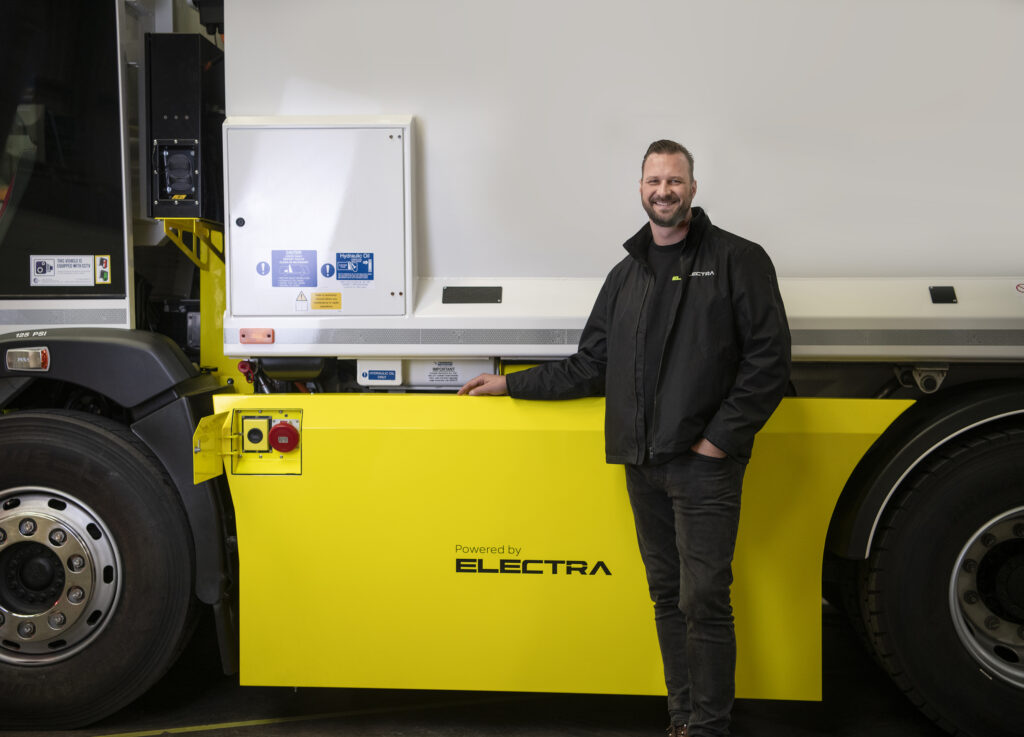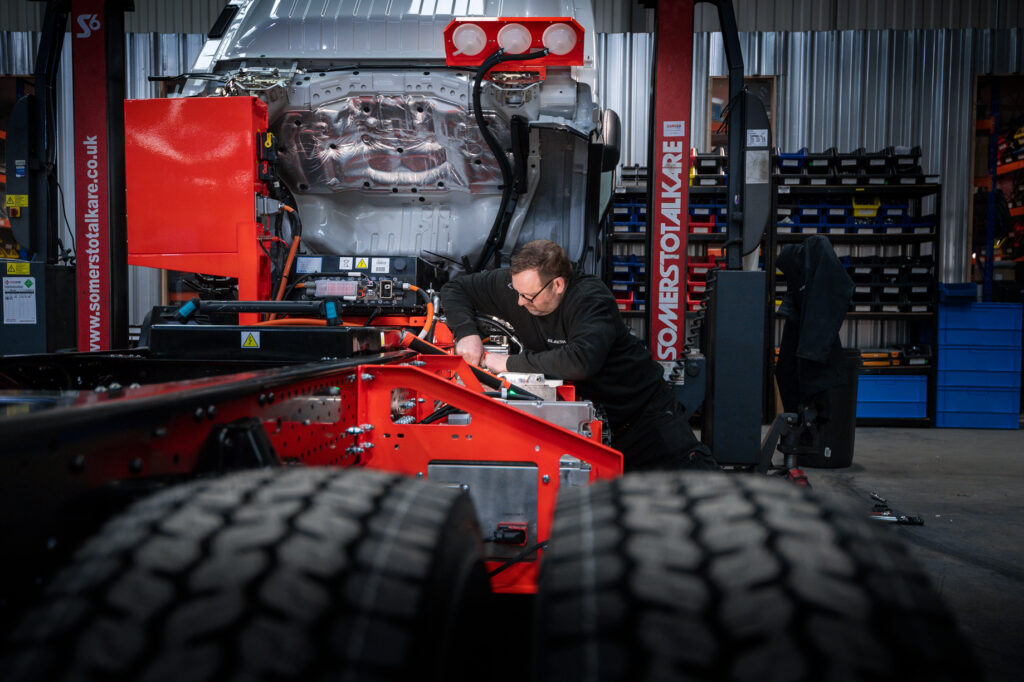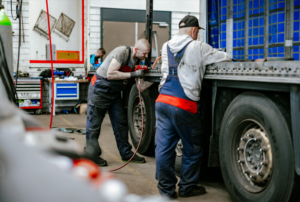Agile electric and hydrogen vehicle manufacturer Electra Commercial Vehicles is thriving in a tumultuous sustainable transport market, and this is down to a business model that prioritises responsiveness, fast turnaround, and the highest quality products, MD Ben Smith tells Ann-Marie Knegt.
In these difficult times, many businesses are struggling, but Electra’s order books are full. So full, in fact, that MD Ben Smith says the company is investing in new larger premises to meet demand. ‘It is frustrating,’ he admits. ‘We’re making it work. We need to build more trucks with better workflow, and we don’t currently have the space.’
It’s a problem that stems from the company’s success, which Ben puts down to being small and agile and working with excellent partners that have stayed the course throughout Electra’s journey. ‘We’ve had five years to get our vehicles working and on the road, whereas our OEM counterparts have had over 100 years to develop ICE powertrains. We had to develop our platform rapidly, and being small meant we could see what worked and what didn’t.’
That development is ongoing. Last year, Electra redeveloped its platform into the Generation 3 range of products. ‘These are a completely new layout with new batteries, compressors, and chargers – nearly all new components are all built-in.
‘The system and layout are designed with an easy-to-maintain configuration. This was my priority because increasing vehicle uptime is pivotal for success.’
When truck wheels are not moving, they aren’t earning, which is a headache for a fleet operator. To help customers keep vehicles on the road, Electra reduced its production time scales from five to six weeks to two, and Ben says the company is aiming to get that down to five days by the second quarter of 2024.
He explains this is partly possible because of Electra’s good supplier relationships. When the business started, buying a large battery for a truck was impossible, so Electra bought modules to build into packs. ‘We then talked to every battery manufacturer worldwide to secure our new systems. We are now working with the world’s largest battery manufacturers. The Gen 3 product line is performing outstandingly well,’ says Ben. ‘We chose a lithium iron phosphate-based battery with the best technology and chemistry behind it, suited to heavy commercials like our platforms. We hope to transition to sodium-based batteries in the future, reducing costs and any safety concerns that arise from typical high-voltage batteries.’
Electra also took a modular approach to the build of the trucks. Electra customers can choose from a tried-and-tested selection of glider chassis and customised wheelbases, matched with a battery suited to the application.

‘When you get into the realms where you need to adapt battery size, or you need an ePTO, that is where we saw our niche,’ says Ben. ‘The concept of the modular approach enables us to place batteries where we need to on the chassis. This led us to build our first-ever top loader and side-loading vehicles, which will be on the roads in the coming weeks. The first vehicle will be in operation with Brighton and Hove.’
He adds: ‘One great example of this flexibility is the release of the Elite Plus cab from Dennis Eagle with luxury interior. Electra is the first manufacturer to provide this cab on an electric vehicle, and we have already engineered and delivered several 4x2s into London with this cab. Having the flexibility to integrate systems into any chassis configuration means Electra can offer zero-emission vehicles and body types for nearly every operation.’
Electra had a ready-made market in the refuse collection sector, thanks to sister company contract hire provider NRG Riverside, which operates a fleet of over 2,000, mainly municipal hire vehicles. This allowed Electra to offer customers the option of leasing vehicles or taking them on a contract-hire basis, which has proved very successful.
Other core markets include food transport, airports and ground services engineering, and Ben says Electra also sees a lot of demand for smaller vehicles at around the 7.5-tonne GVW mark. Electra’s Isuzu glider chassis fits very well in this weight sector, operating to a range of up to 200 miles on one charge.
‘Electra paved the way with the glider chassis,’ says Ben. ‘This was a considerable achievement, and again, it is down to robust relationships with OEMs supplying these chassis. The benefit of building our platforms on these worldwide used products has been one of the reasons for our success. The cost to develop a chassis from scratch, I believe, has proved to be a detriment to the new start-up EV platforms.’
Ben emphasises that any Electra platform will do the job correctly. One of the areas the business is focusing on is ground support equipment. ‘We currently have a demonstrator, which is going to a large airside operator. Electra also delivered their first fully electric aircraft refuelling truck to Kerry Airport in Ireland, which has been performing well for over a year. ‘We have just signed a deal with a major petroleum company with three units on order and another order of two coming our way. It is fascinating to venture into these new markets.’
Behind the vehicles is another factor in Electra’s success – service. This is critical from a customer perspective.
‘We look at all our platforms via telemetry and have implemented preventative maintenance with predictions on what might break formed from the data. We can send a maintenance engineer out within a very short period through our service desk or our partner NRG Riverside’s service desk.’
Electra already supports over 100 operational trucks, but Ben is ramping up its support services. ‘We don’t just know what can break on an electric truck, we know how to fix it. From the years under our belt from supporting our earlier platforms, this has given us an edge on the market when it comes to support.’
He adds that parts supply was a bit of a rocky road during Covid, just like in other industries, but says everything fell into place when Electra changed to its Gen 3 design. ‘We now stock a large volume of “kits” to build our platforms and spare parts for most vehicles. For some chassis orders, we stock over 50 truck chassis, so we can ramp this up and down to meet customers’ demands easily.’
All trucks have the same components, thanks to the modular approach. Once technicians know the Electra operating system on one of the platforms, they know them all, and this is also true for Electra’s hydrogen fuel cell platform.
This was a benchmark for the company and a significant innovation for the market. Electra’s 19-tonne temperature-controlled hydrogen vehicle was operated by Sainsbury’s as part of phase one of the Tees Valley Road to Hydrogen Programme. With a range of around 600 km on one hydrogen fuelling – the equivalent of 325-350 miles with only 20kg of hydrogen – it was a test bed for Electra, built quickly and trialled for only a short period. However, it performed so well that Electra is now involved in part two of the Tees Valley hydrogen programme, which will see the company deliver nine further 19-tonne hydrogen trucks.
This is just one of the innovation projects Electra is currently involved in, but Ben says the main focus is on upscaling production while working on developing the Gen 4 range. ‘Bench building is speeding up production dramatically. Our batteries are pre-manufactured, and we can fully assemble them in their metal work frames on the bench. All the trucks have the batteries pre-built with all the pipework and cables pre-fitted, so we can put them on the vehicle immediately, reducing building time.’
The next stage is to develop a battery swap system, which will be essential for companies operating an extensive fleet of vehicles with a small power supply. When all trucks come in simultaneously and need to charge, this poses an issue. However, if you have an area where you can charge batteries with energy from waste or a solar array and quickly swap charged batteries into trucks, you can double-shift vehicles without the need to charge them. ‘You wouldn’t need a large capacity charger, and if you only have limited depot space, this would work well for a quick turnaround,’ says Ben.
It would also mean fleets can operate more electric vehicles without concerns about their power supply, making their operations more cost-effective.
‘We have the data that proves electric HGVs can do the job in multiple applications,’ says Ben. ‘They can easily manage waste, refrigerated transport, winter maintenance, and even tractor units with a 100-plus mile range. But the biggest factor for electric adoption is infrastructure. The battery-swap concept will reduce infrastructure costs.’
Ever the innovator, Electra is already considering what the future might hold for this technology and how it can benefit customers. ‘Perhaps a leasing concept for batteries to reduce the cost for our clients,’ says Ben. ‘Battery-swap stations for HGVs. We will build whatever we do with the customers’ requirements foremost on our minds.’





